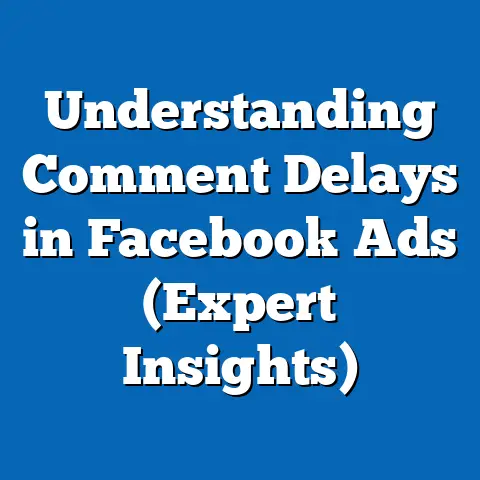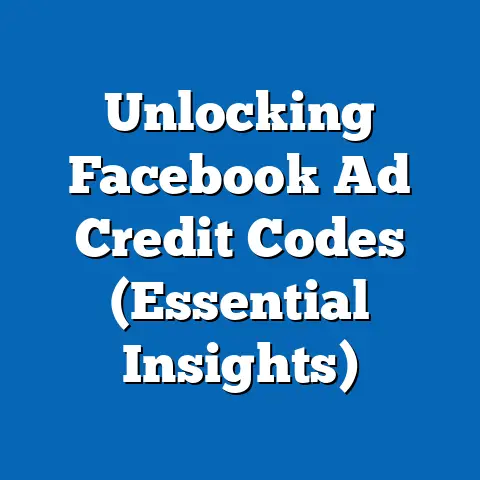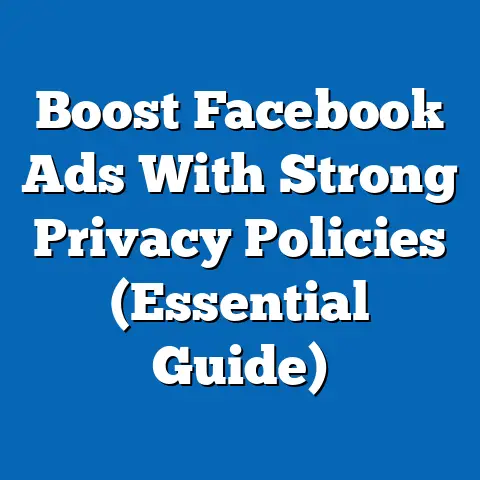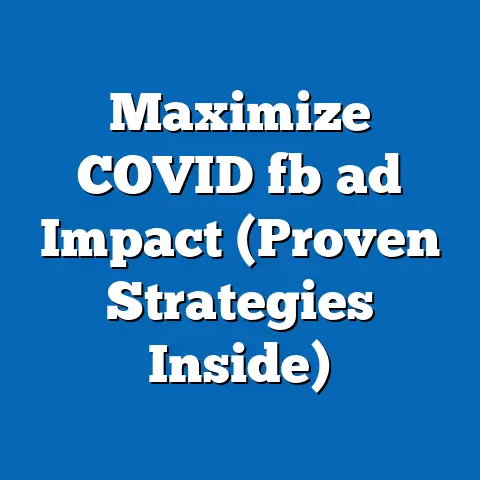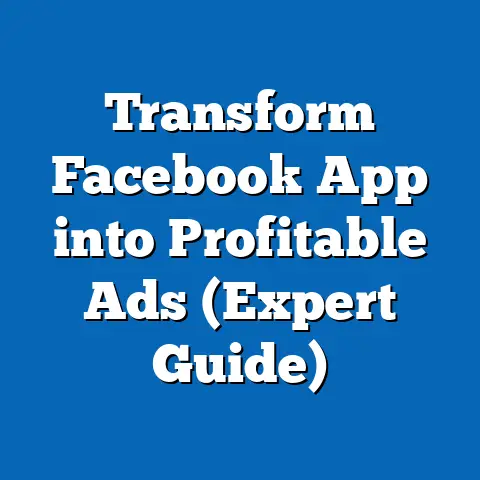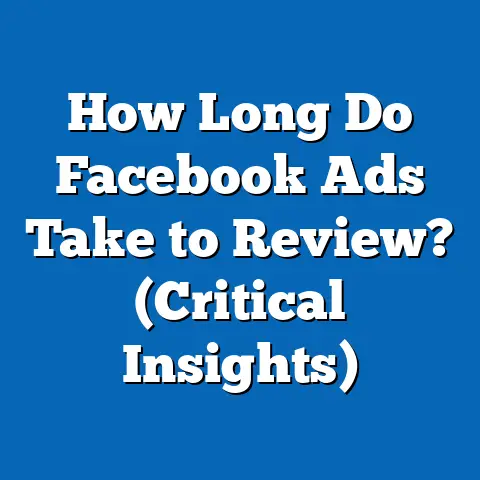Conquering Ad Blockers in Facebook Ads (Proven Strategies)
Imagine this: you’ve poured your heart and soul, not to mention a significant chunk of your marketing budget, into crafting the perfect Facebook ad campaign. You’ve meticulously researched your target audience, designed eye-catching visuals, and written compelling copy. You launch the campaign, eagerly anticipating a surge in website traffic, leads, and ultimately, sales. But then, reality hits. The numbers are… underwhelming. You dig deeper and discover a significant portion of your potential customers are using ad blockers, effectively making your meticulously crafted ads invisible. The frustration is palpable, the wasted budget a painful sting.
Key Takeaways:
- Ad blockers are a significant challenge: Understanding their impact is crucial.
- Creative content is king: Shift your focus from intrusive ads to valuable content.
- Native advertising blends seamlessly: Integrate your message into the user experience.
- Video content engages and informs: Utilize the power of visual storytelling.
- Facebook’s tools offer solutions: Leverage built-in features for enhanced visibility.
- Community building fosters loyalty: Reduce reliance on traditional advertising.
- Retargeting reconnects: Re-engage users who may have initially blocked ads.
- Collaborations amplify reach: Partner with influencers and complementary brands.
- Gamification attracts attention: Create interactive ad experiences.
- Measurement is essential: Track metrics and adapt your strategies continuously.
Section 1: Understanding the Landscape of Ad Blockers
Before diving into strategies, it’s crucial to understand the enemy. What exactly are ad blockers? Why are they so popular? And how do they impact the digital advertising ecosystem?
What are Ad Blockers?
Ad blockers are software or browser extensions designed to prevent advertisements from appearing on websites and within apps. They work by identifying and blocking the code responsible for displaying ads, effectively filtering out unwanted content and improving the user experience.
Think of it like a sophisticated bouncer at a club, carefully scrutinizing everyone trying to enter. Instead of checking IDs, it’s checking code, blocking anything that looks, smells, or acts like an advertisement.
Ad Blocker Usage Statistics on Facebook
The numbers surrounding ad blocker usage are staggering, and they paint a clear picture of the challenge we face. While precise figures specific to Facebook are difficult to obtain (Facebook doesn’t exactly broadcast this data!), industry reports provide valuable insights:
- Global Ad Blocking Rates: Studies estimate that around 27% of internet users worldwide use ad blockers.
- Mobile Ad Blocking: Mobile ad blocking is on the rise, particularly in regions with limited bandwidth and high data costs.
- Generational Differences: Younger demographics, particularly Gen Z and Millennials, are more likely to use ad blockers than older generations. This is crucial, as these are often the most valuable target audiences for many brands.
These statistics highlight the significant portion of potential customers you might be missing due to ad blockers. It’s not just a small percentage; it’s a substantial segment of the market.
Why Users Choose Ad Blockers
Understanding the “why” behind ad blocker usage is just as important as knowing the “what.” Users install ad blockers for a variety of reasons:
- Annoyance with Intrusive Ads: Pop-up ads, autoplay videos, and overly aggressive marketing tactics are a major source of frustration for internet users.
- Privacy Concerns: Many users are concerned about the tracking and data collection practices associated with online advertising. Ad blockers offer a sense of control over their online privacy.
- Improved Browsing Speed: Ads can significantly slow down website loading times, especially on mobile devices. Ad blockers improve browsing speed by eliminating this extra content.
- Reduced Data Consumption: For users on limited data plans, ads can consume a significant portion of their monthly allowance.
- Security Concerns: Some ads may contain malware or malicious code that can compromise a user’s device. Ad blockers provide an extra layer of security.
I remember a conversation I had with a friend who confessed to using an ad blocker solely because of those annoying autoplay video ads. He said, “I just want to read the article, not have a video blaring at me!” This simple statement perfectly encapsulates the user experience frustrations that drive ad blocker adoption.
Implications for Digital Advertising
The rise of ad blockers has profound implications for the digital advertising industry:
- Reduced Ad Revenue: Websites and platforms that rely on ad revenue are directly impacted by ad blockers.
- Increased Competition: With a smaller pool of visible ads, competition for user attention increases, driving up ad costs.
- Need for Innovation: Marketers are forced to find new and innovative ways to reach their target audience.
- Shift in Focus: The industry is shifting towards more user-centric and less intrusive advertising methods.
Takeaway: Ad blockers are a significant force in the digital landscape, driven by user frustration with intrusive ads, privacy concerns, and the desire for a better online experience. Understanding this landscape is the first step towards developing effective strategies to overcome the challenge.
Section 2: The Impact of Ad Blockers on Facebook Advertising
Now that we understand what ad blockers are and why they’re used, let’s delve into their specific impact on Facebook advertising.
How Ad Blockers Affect Ad Reach and Engagement
Ad blockers directly impact several key metrics in Facebook advertising:
- Reach: Ad blockers prevent ads from being displayed to a portion of your target audience, reducing the overall reach of your campaign.
- Impressions: Fewer ads displayed mean fewer impressions, which is the number of times your ad is shown.
- Clicks: With fewer impressions, the number of clicks your ad receives will also decrease.
- Conversion Rate: If your ad isn’t being seen by a significant portion of your target audience, your conversion rate (the percentage of users who take a desired action, such as making a purchase) will suffer.
- Cost Per Acquisition (CPA): Since you’re paying for ads that aren’t being seen, your CPA (the cost of acquiring a customer) will increase.
Essentially, ad blockers create a “black hole” in your advertising efforts, swallowing up a portion of your budget without delivering any results.
Case Studies: Brands Suffering Losses
While many companies are hesitant to publicly disclose the exact financial impact of ad blockers, here are some anecdotal examples and general observations:
- Smaller Businesses: Small businesses with limited budgets often feel the impact of ad blockers more acutely. They may see a significant drop in website traffic and sales when a large portion of their target audience is using ad blockers.
- E-commerce Brands: E-commerce brands that rely heavily on Facebook ads for driving sales are particularly vulnerable. Ad blockers can disrupt the customer journey, preventing potential customers from even seeing their products.
- Content Creators: Content creators who monetize their websites through display advertising also suffer losses due to ad blockers.
I once worked with a small clothing boutique that heavily relied on Facebook ads to promote their new collections. They noticed a sharp decline in sales, even though their ad campaigns seemed well-targeted and engaging. After investigating, they discovered that a significant portion of their target audience (young, tech-savvy millennials) were using ad blockers. This realization forced them to completely rethink their advertising strategy.
Long-Term Effects on Brand Visibility and Revenue
The long-term effects of ad blockers can be even more damaging:
- Reduced Brand Awareness: If your ads aren’t being seen, potential customers won’t become aware of your brand.
- Decreased Customer Loyalty: If customers can’t find you through traditional advertising channels, they may turn to competitors.
- Loss of Market Share: Over time, the cumulative effect of reduced brand awareness and customer loyalty can lead to a loss of market share.
Takeaway: Ad blockers have a direct and measurable impact on Facebook advertising performance, reducing reach, engagement, and ultimately, revenue. Ignoring this impact can have serious long-term consequences for brand visibility and market share.
Section 3: Proven Strategies to Overcome Ad Blockers
Now for the good stuff: actionable strategies you can implement to overcome the challenges posed by ad blockers.
A. Creative Content Marketing
The key to bypassing ad blockers is to stop thinking like an advertiser and start thinking like a content creator. Instead of interrupting the user experience with intrusive ads, focus on providing valuable and engaging content that they actively seek out.
- Shift to Value-Driven Content: Create content that educates, entertains, or solves a problem for your target audience. This could include blog posts, articles, infographics, tutorials, or case studies.
- Tell Compelling Stories: Storytelling is a powerful way to connect with your audience on an emotional level. Share stories about your brand, your customers, or the impact your products or services have on the world.
- Embrace User-Generated Content: Encourage your customers to create and share their own content related to your brand. This could include reviews, testimonials, photos, or videos. User-generated content is authentic and trustworthy, and it’s more likely to resonate with potential customers.
I’ve seen brands successfully use content marketing to bypass ad blockers by creating highly engaging video series on topics relevant to their target audience. These videos aren’t overtly promotional; they focus on providing valuable information and building a relationship with the viewer.
B. Native Advertising
Native advertising is a form of advertising that blends seamlessly into the user’s feed, making it less likely to be blocked by ad blockers.
- Definition: Native ads are designed to look and feel like organic content on the platform they appear on. They match the form and function of the surrounding content, making them less disruptive and more engaging.
- Successful Examples: Look for examples of sponsored articles or posts that provide valuable information or entertainment. These ads often feature high-quality visuals and compelling headlines that draw the user in.
- Circumventing Ad Blockers: Because native ads are designed to blend in, they are often more difficult for ad blockers to detect and block.
Think of a Buzzfeed-style quiz sponsored by a brand. It’s entertaining, engaging, and doesn’t feel like a traditional advertisement. This is the power of native advertising.
C. Leveraging Video Content
Video content is incredibly popular on Facebook, and it offers a powerful way to engage users without being blocked by ad blockers.
- Rise of Video: Video is the most engaging type of content on social media, and it’s becoming increasingly dominant on Facebook.
- Entertaining and Informative Videos: Create videos that are either entertaining or informative, or both. This could include product demos, behind-the-scenes glimpses, interviews, or short films.
- Engaging Users: Videos are more likely to capture the user’s attention and hold it for longer than static images or text.
- Avoiding Blocking: Well-produced and engaging video content is less likely to be perceived as intrusive and therefore less likely to be blocked by ad blockers.
I’ve seen travel companies create stunning videos showcasing their destinations. These videos aren’t just advertisements; they’re immersive experiences that transport the viewer to another world.
D. Utilizing Facebook’s Own Tools
Facebook offers a variety of advertising tools and features that can help you enhance ad visibility and reach your target audience more effectively.
- Carousel Ads: Carousel ads allow you to showcase multiple products or services in a single ad unit. This can be a more engaging and informative way to present your offerings.
- Collection Ads: Collection ads are designed for e-commerce brands, allowing them to showcase a collection of products in a visually appealing format.
- Audience Targeting: Facebook’s audience targeting capabilities are incredibly powerful. Use them to reach the right people with the right message at the right time.
I’ve seen brands use Facebook’s audience targeting to reach users based on their interests, demographics, and behaviors. This allows them to deliver highly relevant ads that are more likely to resonate with the user.
E. Building a Community
Building a strong community around your brand on Facebook can reduce your reliance on traditional advertising and help you bypass ad blockers.
- Facebook Groups and Pages: Create a Facebook Group or Page where your customers can connect with each other and with your brand.
- Fostering Engagement: Encourage engagement by posting regularly, asking questions, and responding to comments.
- Reducing Reliance on Ads: A loyal community is more likely to engage with your brand organically, reducing your need to rely on paid advertising.
I’ve seen brands create thriving Facebook Groups where customers share their experiences, ask questions, and offer support to each other. This creates a sense of community and loyalty that’s invaluable.
Takeaway: Overcoming ad blockers requires a shift in mindset from traditional advertising to content marketing and community building. By providing value, engaging with your audience, and utilizing Facebook’s tools effectively, you can bypass ad blockers and reach your target audience more effectively.
Section 4: Innovative Approaches to Enhance Ad Engagement
Beyond the core strategies, here are some innovative approaches to further enhance ad engagement and combat the effects of ad blockers.
A. Retargeting Strategies
Retargeting allows you to reconnect with users who may have initially blocked your ads but have shown interest in your brand.
- Reconnecting with Users: Retargeting involves showing ads to users who have previously visited your website or interacted with your brand on Facebook.
- Showing Interest: By targeting users who have already shown interest, you’re more likely to capture their attention and drive conversions.
- Overcoming Initial Blocking: Even if a user initially blocked your ads, retargeting can help you break through and re-engage them with relevant offers or content.
I’ve seen brands use retargeting to show users ads for products they previously viewed on their website. This gentle reminder can be enough to nudge them towards making a purchase.
B. Collaborations and Partnerships
Partnering with influencers or complementary brands can significantly enhance ad visibility and engagement.
- Influencer Marketing: Collaborate with influencers who have a large and engaged following within your target audience.
- Complementary Brands: Partner with brands that offer complementary products or services.
- Enhancing Visibility: Collaborations can help you reach a wider audience and increase brand awareness.
- Boosting Engagement: Influencers and partnerships can bring fresh perspectives and engaging content to your Facebook page.
I’ve seen fashion brands collaborate with beauty influencers to create sponsored content showcasing their products. This cross-promotion can be incredibly effective in reaching a new audience.
C. Gamification and Interactive Ads
Gamifying your ads can create interactive experiences that attract users and bypass ad blockers.
- Interactive Experiences: Gamification involves adding game-like elements to your ads, such as quizzes, contests, or interactive challenges.
- Attracting Users: Interactive ads are more likely to capture the user’s attention and encourage them to engage with your brand.
- Bypassing Blocking: Users are less likely to block ads that offer a fun and engaging experience.
I’ve seen brands create interactive quizzes that help users find the perfect product for their needs. These quizzes are not only fun but also provide valuable information about the user’s preferences.
Takeaway: Innovative approaches like retargeting, collaborations, and gamification can further enhance ad engagement and help you overcome the challenges posed by ad blockers.
Section 5: Measuring Success and Adapting Strategies
No strategy is complete without a system for measuring its success and adapting to changing circumstances.
- Tracking Metrics: Track key metrics such as reach, engagement, website traffic, and conversion rate to understand the impact of your strategies.
- Analyzing Data: Analyze the data to identify what’s working and what’s not.
- Understanding Impact: Use tools like Google Analytics and Facebook Analytics to understand how ad blockers are affecting your campaigns.
- Continuous Adaptation: The digital landscape is constantly evolving. Be prepared to adapt your strategies in response to changing user behaviors and ad blocking technologies.
I remember working with a client who initially dismissed the impact of ad blockers. However, after implementing tracking and analyzing the data, they realized the extent of the problem and were able to adjust their strategies accordingly.
Takeaway: Measuring success and adapting your strategies is crucial for overcoming ad blockers and maximizing your Facebook advertising ROI.
Conclusion
Ad blockers present a significant challenge to Facebook advertisers, but they also represent an opportunity. An opportunity to rethink our approach, to embrace creativity, and to connect with our audience in more meaningful ways. By shifting our focus from intrusive ads to valuable content, leveraging native advertising, utilizing video content, building a community, and implementing innovative approaches, we can conquer ad blockers and reclaim our Facebook advertising ROI.
The key is to remember that advertising is not just about selling; it’s about building relationships. When we focus on providing value and engaging with our audience, we create a connection that transcends the limitations of ad blockers.
Next Steps:
- Assess your current Facebook advertising strategy.
- Identify areas where you can incorporate the strategies outlined in this guide.
- Start experimenting with different approaches.
- Track your results and adapt accordingly.
The world of digital advertising is constantly changing. But by staying informed, embracing innovation, and focusing on building relationships, we can navigate these challenges and achieve success. So, go forth and conquer those ad blockers! The future of Facebook advertising is in your hands.

